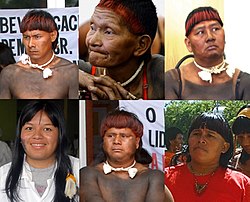Xavante people
 |
|
| Total population | |
|---|---|
| 15,315 | |
| Regions with significant populations | |
| Brazil | |
| Languages | |
| Xavante language |
The Xavante (also Shavante, Chavante, Akuen, A'uwe, Akwe, Awen, or Akwen) are an indigenous people, comprising 15,315 individuals within the territory of eastern Mato Grosso state in Brazil. They speak the Xavante language, part of the Jé language family.
They were enslaved in the 18th century, after which they have tried to avoid contact. A temporary coexistence with westernized society in the 19th century in the state of Goiás, was followed by withdrawal to Mato Grosso (between 1830–1860). They were "re-discovered" during the 1930s. From 1946 to 1957, they were brought under Getúlio Vargas’ National Integration Program, but still experienced massacres and disease. Due to this history, they have a distrust of White or Portuguese men. Today they are still wary of any approach of non-Xavante, called "waradzu".
The Xavante leader Mário Juruna was the first indigenous Brazilian to become a federal representative.
The Xavante, like other indigenous tribes, were treated badly by the white men beginning in the 1960s, the Xavante were moved from their homeland in Mato Grosso to a southern, malnourished area of Brazil. There, thousands of Indians died due to disease, famine and warfare. Within the last decade, the Xavante have been relocated back to their original lands. Unfortunately, due to landgrabbing and squatters, the land was destroyed. Lush forest was burned to create sparse wasteland and pasture.
Recently, John Carter has aided the Xavante by donating 100 head of cattle to the tribe. He continually stands up for the people and is currently on friendly terms with the chief and the members. While their condition is still dire, surviving off of only rice and what little vegetables they can grow on their land, the Brazilian government is finally stepping in to help out the Xavante people.
A 2015 genetic study reached a surprising conclusion about the origins of the Karitiana people. Unlike other Native American peoples, the Paiter-Surui, Karitiana, and Xavante have an ancestry partially related to indigenous Australasian populations of the Andaman Islands, New Guinea, and Australia. Scientists speculate that the relationship derives from an earlier people, called "Population Y", in East Asia from whence both groups diverged 15,000 to 30,000 years ago, the future Australasians migrating south and the remote ancestors of the Xavante northward finding their way to the New World and to the interior Amazon Basin.
...
Wikipedia
